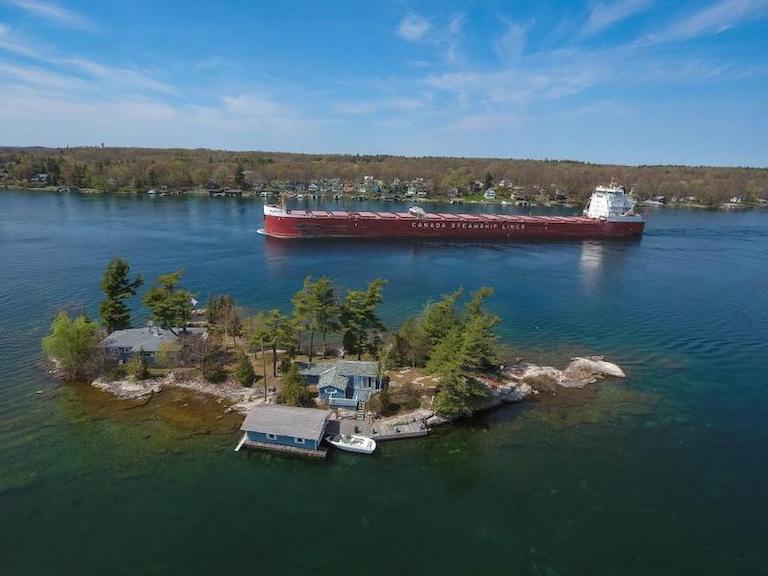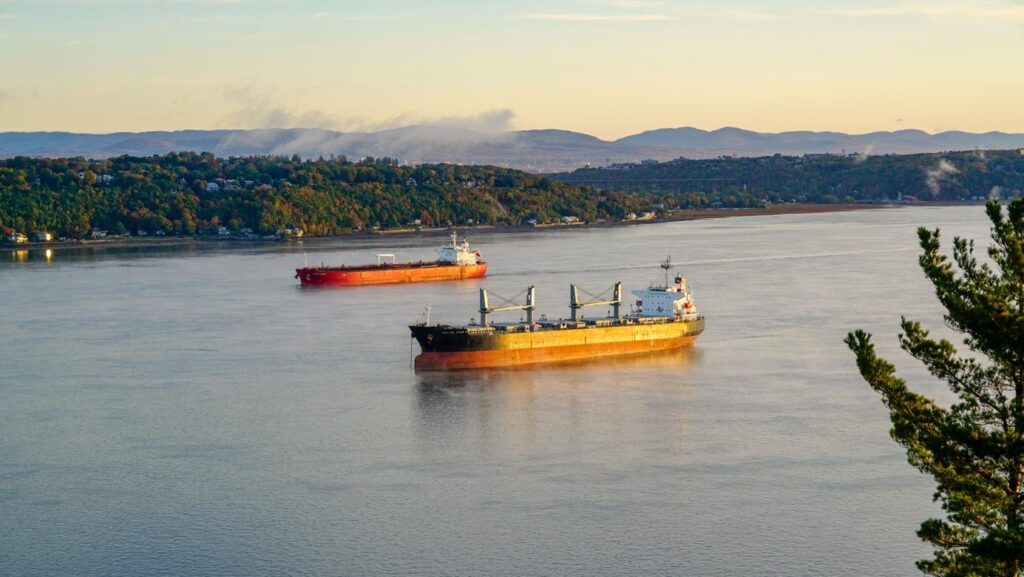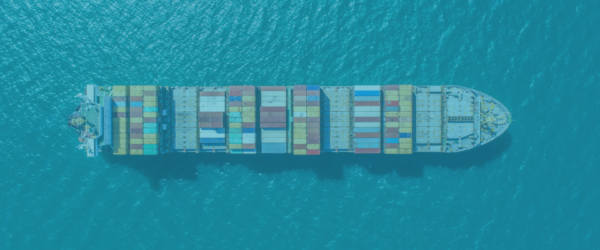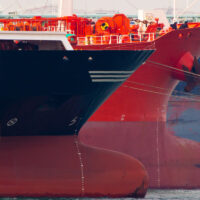Leaders in the global shipping industry are being called upon to take action to reduce their GHG emissions. What can be done?
The St. Lawrence River is one of the world’s major rivers, flowing into the estuary and gulf that shares the same name. It provides nearly 1,200 kilometres of navigable waters that link the Great Lakes and the heart of North America to the Atlantic Ocean, acting as a vital artery for Canada’s economy and supply chain.
Research conducted by an academic team in the Department of Geography at Laval University (Quebec) focuses on climate change and energy transition in the shipping industry in the St. Lawrence River region. This article describes some of the research team’s findings.
Impacts of climate change on the St. Lawrence River and maritime activities in the region
In recent years, the effects of climate change have been felt in the St. Lawrence-Great Lakes region. These impacts include greater variations in water levels, stronger currents and higher risks of flooding and shoreline erosion. These natural phenomena sometimes force ships to temporarily suspend operations in the region or reduce the amount of cargo they carry on board for safety reasons, affecting the profitability of voyages and the fluidity of the supply chain. Many port facilities are already experiencing the impacts of climate change. These include the ports of Cleveland, Ohio, and Milwaukee, Wisconsin, whose facilities were damaged by flooding along Lakes Erie and Michigan in 2019 and 2020, respectively.
How shipping contributes to climate change
Faced with the growing impacts of climate change on the environment, several countries, including Canada, have committed to reducing greenhouse gas emissions, which are the source of many of the climate disturbances currently observed. Achieving this objective requires an energy transition in all sectors of activity, including the shipping industry.
Like many other industries, shipping contributes to climate change through, among other things, greenhouse gas (GHG) emissions from ships. Indeed, it is estimated that the shipping industry is responsible for nearly 3% of global greenhouse gas emissions. Carbon dioxide (CO2) is the main greenhouse gas emitted by shipping.
In addition to CO2, shipping also contributes to climate change through its emissions of black carbon (tiny black particles) from fuel combustion and methane, a potent greenhouse gas from the use of liquefied natural gas. Ships burning heavy fuel oil produce the largest amount of black carbon particles. Black carbon accounts for 21% of CO21 equivalent emissions from ships and is the second largest contributor to climate change after CO2. However, there are currently no regulations to control black carbon and methane emissions from shipping. Discussions are still underway to find ways to reduce them. The only regulations in place, to date, are for CO2.
In order to meet the objectives of the Paris Agreement to limit global temperature warming to 2°C, sectors such as shipping must take action to minimize their carbon emissions. What are shipping companies in Canada, and particularly in the St. Lawrence River region, doing to reduce their carbon footprint and meet national and international emission reduction targets? This article provides an overview of the GHG reduction initiatives put in place by the International Maritime Organization (IMO) and the responses of some of the shipping companies operating on the St. Lawrence River to combat climate change.
International Maritime Organization actions to reduce greenhouse gases from ships
The IMO is the agency responsible for the safety and security of international shipping and the prevention of pollution from ships. Since 1997, the IMO has been working to regulate GHG emissions from shipping and only in 2018 did it adopt a strategy for reducing GHGs from commercial ships. The IMO strategy aims to reduce GHG emissions from international shipping by at least 50% from 2008 levels by 2050. And while it is considered the most carbon-efficient mode of transportation, actions must be taken to decarbonize it. While the ways in which the shipping industry can significantly reduce its GHG emissions are still under development, several promising options exist.
The IMO GHG reduction strategy defines a timetable and includes a non-exhaustive list of possible measures for the short (2018-2023), medium (2023-2030) and long term (beyond 2030). These strategies fall into three categories: technological measures, operational measures, and market-based measures. Technological measures include the development and installation of GHG reduction technologies onboard ships. Operational measures aim to improve a ship’s operations through voyage optimization, reduction of ship operational speed and hull maintenance. Market-based measures, such as the European Union Emissions Trading Scheme and carbon pricing, are non-technological measures with economic overtones that can provide incentives for shipping stakeholders to take action to reduce their emissions. They can generate revenue and contribute to climate policy funding in other sectors.
Overview of measures to reduce greenhouse gas emissions from shipping
The Energy Efficiency Design Index
The Energy Efficiency Design Index (EEDI) is a non-prescriptive, performance-based mechanism that allows the industry to choose which technologies to use in a specific ship design. As long as the required level of energy efficiency is achieved, ship designers and builders are free to use the most cost-effective solutions to bring the ship into compliance. For new ships, the EEDI is the most important technology measure, as it promotes the use of more efficient and energy-saving equipment and engines and, therefore, less pollution.
The EEDI is being developed for the largest and most energy-intensive ships, including oil tankers, bulk carriers, LNG carriers, general cargo ships, container ships, and refrigerated and mixed cargo ships. In 2014, the IMO’s Marine Environment Protection Committee (MEPC) amended the EEDI regulations to extend their application to LNG carriers, vehicle carriers, passenger ships, and cruise ships. Ships responsible for approximately 85% of CO2 emissions from international shipping are now included in the international regulatory regime.

The Ship Energy Efficiency Management Plan
The Ship Energy Efficiency Management Plan (SEEMP) is an operational solution that establishes a mechanism to improve a ship’s energy efficiency in a cost-effective manner. The SEEMP provides an approach for shipping companies to manage ship and fleet efficiency performance over time using, for example, the Energy Efficiency Operational Indicator (EEOI) as a monitoring tool. The SEEMP development guidance for new and existing ships incorporates best practices for fuel-efficient ship operation, as well as guidelines for voluntary use of the EEOI by shipowners. The EEOI allows shipowners to measure the energy efficiency of an operating ship and assess the impact of any operational changes, including better voyage planning, more frequent propeller cleaning, or the introduction of technological measures such as heat recovery systems. The SEEMP urges the shipowner and operator at each stage of the plan to consider new technologies and practices when seeking to optimize a ship’s performance.
Furthermore, in June 2021, the Marine Environment Protection Committee (MEPC) proposed two new regulations that will impact shipowners worldwide: the Energy Efficiency Existing Ship Index (EEXI) and the Carbon Intensity Indicator (CII). These are short-term measures required under Annex VI of the International Convention for the Prevention of Pollution from Ships (MARPOL). Technical standards for newly built ships via the Energy Efficiency Design Index (EEDI) are expanded to include existing ships via the Energy Efficiency Existing Ship Index (EEXI). Shipowners must now ensure that their ships are inspected annually by classification societies – independent organizations responsible for enforcing technical standards for ship construction, monitoring maintenance activities and compliance inspections – using the EEXI.
The EEXI requires ship operators to assess the energy consumption and CO2 emissions of their fleet against specific energy efficiency requirements for each ship type. The SEEMP, which is mandatory for ships built in 2013 or later, is strengthened by introducing annual requirements for the Carbon Intensity Indicator (CII).
The CII determines the annual reduction factor needed to ensure continuous improvement of a ships’ operational carbon intensity of ships within a specific rating level. The rating – A, B, C, D or E – is assigned based on the operational carbon intensity. The letter A represents a very high level of performance, while the letter E represents a lower level of performance. A ship running on low-carbon fuel, for example, scores higher than a ship running on fossil fuels. Shipowners and operators can adopt the common practice of slowing down their speed to reduce fuel costs and their carbon footprint. The level of performance is recorded in the ship’s Energy Performance Management Plan. A ship that has achieved a rating of D for three consecutive years or E for one year must submit a corrective action plan to show how the required rating (C or better) will be achieved. Port authorities and classification societies are encouraged to offer incentives to ships with a rating of A or B.
Short-term measures, such as the EEXI and the CII, that aim to achieve carbon intensity reduction targets are included in the IMO strategy. However, they are not sufficient to allow the shipping industry to achieve zero carbon emissions (net zero). This situation is likely to prompt governments to adopt legislation such as carbon taxes that impose emission reductions on the shipping industry.
In short, technological and operational measures to reduce greenhouse gas emissions from ships include:
| Technical measures to reduce emissions | |
| Shore power | Allows ships to shut down their auxiliary engines while docked, thereby reducing fuel consumption and emissions in ports. |
| Hull and superstructure design | Rationalization of hull and superstructure design and reduction of hull weight to minimize ship resistance in the water and fuel consumption. |
| Hull coatings | Coatings to minimize the resistance of ships in the water and their fuel consumption. |
| Propulsion system upgrades | Improving the efficiency of older engines by upgrading and adding technologies such as blades, vanes, ducts and turbulence devices to increase fuel efficiency and reduce GHG emissions. |
| Waste heat recovery | Use of waste heat from engines to drive turbines to produce electricity. Thus, less fuel is needed for electricity production. |
| Alternative fuels and energy sources | Replacement of fossil fuels with neutral or low-carbon fuels, such as biofuel, hydrogen, ammonia, fuel cells, and wind power. |
| Design, speed and
capacity |
Improved original design specifications such as beam, draft, size and speed to increase the ship’s energy efficiency. |
| Operational measures | |
| Voyage planning | Use of meteorological information and ocean currents to improve voyage planning and execution and thus minimize fuel consumption and ship emissions. |
| Speed reduction | Slowing down the speed of ships to save fuel and reduce GHG emissions. |
| Maintenance | Eliminate any inefficiencies or sources of resistance in propellers, hulls and engines through periodic maintenance. |
| Trim and ballast optimization | Trim and ballast optimization can reduce the drag experienced by the ship while in the water. |
Source: Chadli Yaya, 2021, based on Xing et al., 20202; Shi, 2016.3
GHG emission reduction measures prioritized in the St. Lawrence River region
As mentioned earlier, the shipping industry’s contribution to the achievement of the Paris Agreement requires substituting fossil fuels with alternative carbon-neutral fuels. Currently, the actors of the global shipping industry, including those in the St. Lawrence region, are being called upon to take action to reduce their GHG emissions.
Shipping companies operating on the St. Lawrence River have already adopted certain measures in this regard, including energy efficiency measures and the switch to biofuels. For example, two major companies – The CSL Group, a private Canadian shipping company headquartered in Montreal, and Groupe Desgagnés, a Quebec-based shipping group headquartered in Quebec City – are taking steps in these two areas. On the energy efficiency side, CSL Group is implementing waste heat recovery, which is a system that recycles thermal energy generated by the ships’ engines and reduces fuel consumption by 8-10%, and Groupe Desgagnés is using weather routing, which means choosing the ships’ minimum resistance route by selecting calm weather conditions to avoid additional resistance from waves and air. Both companies use speed reduction, which has proven to be the most energy-efficient operational measure for ships. In terms of switching to alternative fuels, The CSL Group is exploring biofuel (e.g., bioethanol, biodiesel) as an alternative energy source, much of which is derived from biomass such as plants, algae, or waste. Groupe Desgagnés is beginning to use LNG (liquefied natural gas), which could reduce CO2 emissions by about 20-25% compared to traditional marine fuel oils, which in practice amounts to a reduction of about 12-20% in net GHG emissions due to the potential for methane slip.
Port authorities in the St. Lawrence region are also introducing energy efficiency measures. The Port of Montreal is using on-shore power for ships, including cruise ships. The Port of Quebec is introducing natural gas as a new ship refueling service and reducing port fees for environmentally responsible shipowners. The Port of Saguenay is installing electric conveyors, and the Port of Sept-Îles is reducing ship waiting times by purchasing new loading equipment.

Paving the way for a decarbonized shipping industry
Despite the awareness of the need to reduce GHG emissions, this objective is not yet a priority for all companies. Some have taken a proactive approach by joining sustainability programs while others are taking a wait-and-see approach due to the technological and economic challenges associated with decarbonizing shipping.
Government, ports and classification societies have an important role to play in making the decarbonization project a reality, as the IMO does not have the authority to control GHG emissions at the state level. Each country must therefore ensure the application of international rules in their jurisdictions. In addition, stakeholders in the shipping industry must cooperate with each other. Sharing knowledge, particularly in the area of innovation, is essential as it will promote the sharing of best practices between policy makers, environmental and climate change experts, technology developers and shipping industry representatives. The IMO also needs to undertake numerous pilot projects to help countries implement the proposed measures to mitigate greenhouse gases from shipping.
Research Team
This article was written in collaboration with the research team in the Department of Geography at Laval University (Quebec).

Chadli Yaya is a PhD student in the Department of Geography at Laval University (Quebec). He is working under the supervision of Professor Frédéric Lasserre. Chadli holds a Master’s degree in transportation economics from the University of Abomey-Calavi in Benin and a Master’s degree in logistical transportation from the Université Libre de Bruxelles in Belgium.

Professor Frédéric Lasserre is a full professor in the Department of Geography and director of the Quebec Council for Geopolitical Studies.
References
1ICCT, 2020. New IMO study highlights sharp rise in short-lived climate pollution. Retrieved from https://theicct.org/news/fourth-imo-ghg-study-finalreport-pr-20200804
2Xing, H., S. Spence, and H. Chen. 2020a. A comprehensive review on countermeasures for CO2 emissions from ships. Renewable and Sustainable Energy Reviews 134: 110222. doi: 10.1016/j.rser.2020.110222.
3Shi, Y. 2016. Reducing greenhouse gas emissions from international shipping: Is it time to consider market-based measures? Marine Policy 64: 123-134. doi: 10.1016/j.marpol.2015.11.013.



